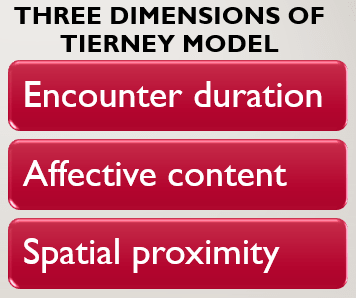Use of three dimensions of Tierney Model
The Price, Arnould and Tierney model for classifying and managing service encounters is a useful example. It uses three dimensions to describe the encounter:
- Encounter duration
- Affective content
- Spatial proximity
For an organization that is considering how to improve its customer service function, whether to go ‘hi-tech’ or ‘hi-touch’, (or both) is a critically important question.
Having a taxonomy of service encounters, and an understanding of what underlies differences between encounters, the service provider can maximize its customer satisfaction and operational efficiency goals.
Duration of Encounter
Duration refers to the temporal aspect of the encounter, i.e. how long it takes. This is important because the interaction moves from one that is very role defined in brief encounters to one that can become almost like a friendship over long encounters. The longer the encounter the more boundary open it becomes with more leakage of emotions.
Therefore, the emotional labor skills required increases as duration increases. Some interactions however have varying affective contents. A hotel check-in may have very little emotional content (if everything goes smoothly).
Affective Content
Affective content increases with increased perceived risk, such as in hairdressing or home decorating and some services are engaged in for their hedonistic or experiential qualities such as the movies. The greater the affective content of the service, the less easy it is to standardize the service process, and the less easy it is to train for.
Indeed, emotional intelligence and other specific personality factors such as self-monitoring becoming increasingly important as the affective content increases.
Spatial Proximity
Finally, the spatial proximity of the interaction affects the type of service encounter. A hairdresser may be allowed to touch a client whilst the same behavior from a bank teller would not only be odd but quite unacceptable. Such close spatial proximity gives rise to varying levels of attachment and involvement.
Indeed, many clients divulge personal aspects of their lives to hairdressers whilst they would hardly think of doing the same with a McDonalds server.
Conclusion
So, we can see that using this taxonomy of service encounters we can build various combinations of high and low duration, affective content and spatial proximity. Encounters that are of low duration, low affective content and that occur when people are not close to each other, or are separated by a desk, would be ideally suited to a ‘hi-tech’ improvement solution, perhaps even dispensing with the human being altogether.
Conversely interactions that are of long duration, high affective content and close spatial proximity, maybe enhanced by technology, but technology will not be the solution to service efficiency. Customer satisfaction derives from the personality and emotional intelligence of the service personnel and creates new human resource challenges for service providers.


